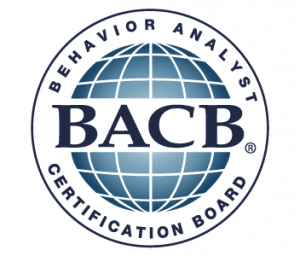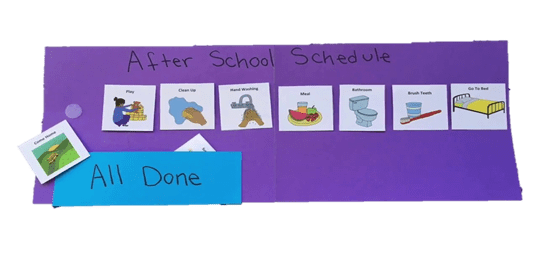Searching for "bcba"

Photo retrieved from BCBA.com
Within the field of applied behavior analysis (ABA), there are many titles a clinician can have. BCBA stands for Board Certified Behavior Analyst. Clinicians who hold this title have received a master’s degree, completed at least 1,500 hours of supervised work with implementation of behavior-analytic work, and taken an international certification exam. At the Husky ABA clinic, we have four faculty advisors who are BCBA-Ds, meaning that they have a doctorate degree in ABA or related behavior.
You may have noticed another title, the BCaBA, Board Certified assistant Behavior Analyst. BCaBA have undergraduate degree, completed at least 1, 000 hours of supervised works, and have passed an international certification exam. BCaBA’s
practice under the supervision of a BCBA, monitoring front-line clinicians that are implementing the individualized interventions the BCBA has created.
Finally, front-line clinicians in ABA, are often Registered Behavior Technicians (RBT). RBTs hands-on with the clients, directly implementing structured programming to help the child to be successful. RBTs work with clients every day to implement the interventions written by the BCBAs. RBTs are heavily supervised by both the BCaBA and BCBA to ensure treatments are implemented with fidelity.
Overall, in ABA, we aim to identify the changes we need to make in the environment to enhance the lives of clients AND the individuals around them like their parents, teachers, classmates, and siblings.
For more information about Applied Behavior Analysis check out https://www.bacb.com
Like us on FaceBook!
 The faculty members in Applied Behavior Analysis(ABA) program value students’ opinions greatly. Let’s take a look at what it’s like to be an ABA graduate student of the on-campus cohort at Saint Cloud State University (SCSU) and what they think about the program after the two-semester worth of experience.
The faculty members in Applied Behavior Analysis(ABA) program value students’ opinions greatly. Let’s take a look at what it’s like to be an ABA graduate student of the on-campus cohort at Saint Cloud State University (SCSU) and what they think about the program after the two-semester worth of experience.
When asked to indicate one aspect of the program that they enjoyed, many students enjoyed the course work and different classes. For example, Behavioral Application, and Experimental Analysis of Behavior.
“I liked having Experimental Analysis of Behavior (EAB) the first semester to increase my understanding of the principles of behavior.”
“The course Behavioral Applications has been the most influential, helpful class to me personally with helpful articles and insightful case study presentations.”
What are students’ experiences with our faculty members? Here are some of the experiences from the students:
“I push myself harder when I’m held to a high standard by my professors. Throughout this program, I’ve really appreciated the high standards set by a couple of my professors in particular. It’s clear that the professors here care about students’ success and want to encourage students to always do better and think outside the box.”
“They have supported me by being available for questions and by encouraging me with my career goals. They also help me to grow in knowledge and application. I am not as scared to be wrong about something, because I know that I will learn from it and be better for it.”
What would the current student tell someone who is interested in applying for the ABA program at SCSU?
“It is a lot of hard work, but I think we will be better providers in the future because of it. If you want the easy way, this is not it, but if you want the RIGHT way, this is definitely it.”
“This ABA program is perfect for anyone that genuinely cares about increasing their skills as a practitioner. This is not an easy program, but it is beyond worth it.”
“This program will go above and beyond to ensure that you completely know the material on a greater level than regurgitation.”
An insight into the program will not be comprehensive without constructive criticism. Right? Do students have any suggestions or aspects of the program that they would like to change?
“One possible aspect of the program that I would change or improve on would be contact or relations with the online program. I think it would be beneficial to have an online chat or possibly Zoom to meet others from both programs to discuss our similar journeys.”
“I would also like to learn more about how to solve complex problems in the clinic and in other settings. I think most of us have experience in a clinic or home, but I would like to learn about how a BCBA implements interventions in a school setting or in a group home.”
Here you have it. Hopefully, by reading students’ experiences, now you have a better insight into what the ABA program at SCSU has to offer. Feel free to visit the program page and contact the faculty members if you have any questions regarding the program.
 Strategies such as planned ignoring and behavior-specific praise are consequence-based interventions. In other words, those strategies come after the behavior has happened. What if we can address the behavior on the front end? This is when Antecedent interventions come into play. Antecedent interventions are designed to change the environment or setting events before a particular behavior occurs to increase the likelihood of positive behavior. Board-certified behavior analysts (BCBAs) often manipulate antecedents to set up opportunities to prompt more positive behavior.
Strategies such as planned ignoring and behavior-specific praise are consequence-based interventions. In other words, those strategies come after the behavior has happened. What if we can address the behavior on the front end? This is when Antecedent interventions come into play. Antecedent interventions are designed to change the environment or setting events before a particular behavior occurs to increase the likelihood of positive behavior. Board-certified behavior analysts (BCBAs) often manipulate antecedents to set up opportunities to prompt more positive behavior.
There are many common types of antecedent strategies:
Using clear and specific instructions: It is important to keep in mind that when you ask your child to do something, be as specific as you can. For example, instead of saying “Go clean up your room.”, “Pick up 3 pieces of clothing on your bedroom floor.” Having clear and specific instructions is not only easier for your child to comply but also your child knows what is being expected. Of course, you do not need to always be so specific with your instructions, but it is helpful when you start developing positive behavior.
Visuals: Research has shown that individuals who are diagnosed with autism spectrum disorder tend to process visual cues better than auditory ones. Using visual schedules to present clear expectations. They are similar to planners we use for school or work but instead of listing all the tasks for the day.

Offer choices: Giving choices is a powerful tool to increase compliance. Using clear and specific instructions might be enough for your child. However, if you have any problems with compliance, by adding choice, you will increase the impact. For example, you could say to your child “Please put on your green gloves or brown gloves, we are going outside.” By offering a choice, it will greatly increase the chance that your child puts something on right away.
The three antecedent strategies mentioned above are helpful tools to increase compliance and decrease unwanted behavior. It is more effective if you combine them with reinforcement strategies (e.g., behavior-specific praise, token economy).
Next week, we will discuss an effective tool: Home-based reinforcement program (HBRP) to manage your child’s behavior in school settings.
 Last week, we introduced planned ignoring to guide your child’s behavior. The idea of planned ignoring is that you deliberately withhold your attention when unwanted behaviors occur. Attention is a powerful reinforcer that you might not realize. Sometimes, even reprimands or negative attention could serve as a reinforcer for children. The questions are how to make planned ignoring more effective and if it is suitable for you and your child.
Last week, we introduced planned ignoring to guide your child’s behavior. The idea of planned ignoring is that you deliberately withhold your attention when unwanted behaviors occur. Attention is a powerful reinforcer that you might not realize. Sometimes, even reprimands or negative attention could serve as a reinforcer for children. The questions are how to make planned ignoring more effective and if it is suitable for you and your child.
One of the most difficult aspects is ignoring. As sometimes, it is extremely difficult to not give in from time to time. Here are some tips when using planned ignoring:
- Plan ways to distract yourself: You should always be proactive and find things or ways to distract yourself from attending to the behavior. You could put on some music, breathe deeply, or think of something irrelevant such as planning your shopping list.
- Start withholding your attention when the behavior starts and provide attention right away when the behavior stops.
- Always give your child positive attention and praise for positive behavior or the alternative behavior. In other words, the behavior you want to see instead.
As not every strategy is suitable for every situation. Here are questions that help you to answer whether planned ignoring is right for you and your child:
Can I ignore the behavior if it gets worse?
We talked about extinction burst in which you would see an expected increase in unwanted behavior. For example, if the unwanted behavior is tapping the table and once you start withholding your attention, they start slamming the table. If you feel that you cannot deal with and simply ignore the behavior, it is better to stick to reinforcement-based strategies.
Should you ignore the behavior?
Some behavior cannot be ignored for obvious reasons. You cannot ignore behaviors that might harm themselves, others.
Is the behavior also reinforced by other’s attention?
The unwanted behaviors could also be maintained by other’s attention. For example, another caregiver, siblings, friends. Therefore, it is difficult to see the desired results when only you are withholding attention for the behavior.
Planned ignoring is not suitable for everyone and every situation. Therefore, you should ask your board-certified behavior analysts (BCBAs) for suggestions.
We will switch gears next week and discuss antecedent strategies that could address unwanted behaviors before they happen.
 In a previous blog, we discuss the strategy of catching children’s good behavior. Another strategy that could be used is called planned ignoring. Planned ignoring is when you deliberately withholding attention when the child is engaging in behavior that you do not want to see, and the behavior would be less likely to happen in the future. It might sound simple enough to implement. However, there are a couple of things that need to be noted to see effective results.
In a previous blog, we discuss the strategy of catching children’s good behavior. Another strategy that could be used is called planned ignoring. Planned ignoring is when you deliberately withholding attention when the child is engaging in behavior that you do not want to see, and the behavior would be less likely to happen in the future. It might sound simple enough to implement. However, there are a couple of things that need to be noted to see effective results.
- Consistency is key
When withholding attention for unwanted behaviors, keep it consistent. In order words, you should be clear with your expectation and the child will understand that the particular behavior will not result in the consequence (reward) they had in the past. For example, your child might yell loudly, as a result, she gets your attention. Now, you would look away or walk out of the room.
- Reinforce other behavior
Planned ignoring should NOT be used alone. Reinforcement-based procedures should always be used in conjunction with planned ignoring. Providing attention when the child engages in behavior that you want to see more of. You need to make sure that the child knows what to do instead. For example. When your child asks for your attention by tapping you in the back, make sure to provide your undivided attention and deliver behavior-specific praise.
- Extinction burst
Extinction bursts are sudden and expected increases in unwanted behavior. Therefore, when you first look away or walk out of the room when your child yells for attention, you might hear your child yells louder as a result. We encounter extinction bursts more often than you think. Think of the time you push an elevator button to close the door. As most of the time, the door does not close immediately. What do you do usually? You push a couple more times or pushing it harder. Therefore, the procedure is working when you see an expected increase in behavior.
Planned ignoring is a strategy that is not easy to implement as you can imagine it is extremely difficult to not give in from time to time. Extinction burst often is not easy to tolerate for most caregivers. Here are some takeaway points:
- NOT using planned ignoring alone: When a board-certified behavior analyst (BCBA) use planned ignoring, Reinforcement based strategies are always used. Attention or praise will be provided for positive behavior to teach the child what to do instead to get attention. For example, if your child is bouncing up and down during dinner time, you could leave them out of your conversation and not looking at them until they sit in the chair nicely. Then, you will immediately say “I love how you sit in your chair. Can you tell us more about your day at school today?”
- It gets worst so it is working: Remember the unwanted behavior tends to get worst for a short period before it gets better. When a BCBA implements planned ignoring, many parents are concerned because the behavior seems to get worst. Having extinction burst in mind will help you to follow through with the plan put in place by a BCBA.
Next week, let us examine some of the tips when using planned ignoring and if this tool is the best option for you and your child.

momjunction.com
It is hard to believe that 10 weeks have passed since our first blog post this semester. If you missed all the posts, not a problem! Let’s revisit all the reinforcement-based interventions that we have covered so far.
First, using reinforcement is not bribing your child. When using reinforcement, caretakers are proactive and it produces long-term positive outcomes. On the other hand, when a parent bribes a child, the child usually is in control and the results are short-lived.
When using reinforcement, you don’t always have to give your child an iPad or candy. A board-certified behavior analyst (BCBA) will suggest that behavior-specific praise could also be a beneficial way to show your approval and letting the child know what she is doing correctly. With behavior-specific praise, not only you are showing excitement towards your child’s behavior, but you are also stating what she is doing right. Behavior-specific praise is an effective way to teach your child to engage in more appropriate behavior (e.g., listen to your instructions, using the word “please”).
It is easy to incorporate behavior-specific praise into your daily routines. However, as we all know, sometimes we are quick to notice when our kids are acting poorly. This phenomenon, negativity bias, means we tend to pay more attention to what is going wrong in the environment and we fail to notice what is going well. It is essential for you to notice and find positive behavior to replace the behavior that you do not want to see. Once you identify the behavior, you will provide behavior-specific praise when you see that positive behavior.
As a parent, you might recognize your child does not know how to perform the positive behavior or your child has great difficulty learning the appropriate behavior. A BCBA might recommend considering a shaping intervention. Shaping is a way to slowly teach skills by celebrating small steps to achieve positive changes to your child’s behavior. For example, it could be something like having the child start doing a couple of the math questions instead of the entire worksheet.
Another reinforcement strategy that you might consider as a parent is a token economy in which could be a useful addition to all the aforementioned reinforcement-based interventions. In the token economy, you provide tokens for positive behavior displayed by the child and the child can exchange those collected tokens for predetermined desired items, activities, or privileges. We outlined the necessary steps for an effective token economy. Also, we discussed useful and practical tips on running a token economy program. When using a token economy you want to make sure your child helps selects rewards he or she can earn in their token system. In addition, remember to use behavior-specific praise when delivering tokens, and deliver tokens when you see easy tasks completed by the child at the beginning of the program.
Reinforcement strategies are widely used and recommend to parents, teachers, and therapists. By providing rewards for positive behavior systematically, children are motivated to perform behaviors that caretakers want to see. They have been proven to be extremely effective for children diagnosed with autism spectrum disorder (ASD).
Remember to visit and like our Facebook page for the latest update on ABA Husky Clinic and future blog posts.

Drink-tokens
Token economy systems are widely used as a part of applied behavior analysis interventions in different settings such as schools, homes, and clinics. The token economy is a method of delivering tokens for positive behavior to increase the frequency of the desired behaviors (e.g., instructions). Later, the tokens can be exchanged for rewards (e.g. treats, time of iPad, social interaction). You might think “well, I am bribing my child to behave.” To that, a board-certified behavior analyst (BCBA) might tell you “token economy is not bribing.” Remember the differences between reinforcement and bribery! Think of it as how you get paid for working. You would not call that bribery, would you?
When using a token economy, here are the necessary steps:
- Select a behavior: If your child has not experienced a token economy, a BCBA might recommend you choose one appropriate behavior initially. This ensures you can provide the token for that specific behavior. For example, using the word “please” when asking for something, going to bed on time, or doing 10 minutes of math homework.
- Choose rewards: Make sure to choose something that your child enjoys. These items can include their favorite, special snacks, activities, toys, or privileges like staying up late or having a pizza night. Of course, you can also ask your child to give you ideas!
- Select tokens: You can use checkmarks, poker chips, smiley faces, or cartoon characters that your child likes. You can find printouts here.
- Track the earned tokens: You could use a chart or a box and place it somewhere you and your child can see and track points easily.
- Determine how many tokens need to be earned: For different rewards, your child needs to earn a varied amount of token to exchange for them. (e.g. one token for a piece of candy, ten tokens for playing 30 minutes of video games). Also, make sure there are various small and big rewards so you child and get smaller rewards immediately or save up tokens for bigger rewards.
Here are some useful tips on running a token economy program:
- Make sure to provide a token along with behavior-specific praise immediately after the selected behavior.
- Start small and easy at the beginning of the program. You could even start by giving one free token to get the program going each day.
- Change up the rewards from time to time so your child will not lose interest.
- Have your child engages in the token economy development and creation. Your child can design the tokens, or what rewards to earn.
We will introduce another graduate senior behavior clinician at the ABA Husky Clinic next week and learn about how he discovers his love for ABA. To explore more ABA related topics and resources, check out our Facebook page.
 Come meet Eva! she is a graduate senior behavior clinician at the Husky ABA Clinic. She provides behavioral therapy services to clients, guiding parents through what is like to implement behavior programs, and training undergraduate and graduate clinicians. She also assists in developing the registered behavior technician (RBT) training modules for the clinic. Through the Husky ABA Clinic, Eva is getting hands-on experience in developing training materials and instructing clinicians. Eva enjoys these responsibilities. She is excited about these new experiences as they will build and enhance her professional skills for her future career aspirations.
Come meet Eva! she is a graduate senior behavior clinician at the Husky ABA Clinic. She provides behavioral therapy services to clients, guiding parents through what is like to implement behavior programs, and training undergraduate and graduate clinicians. She also assists in developing the registered behavior technician (RBT) training modules for the clinic. Through the Husky ABA Clinic, Eva is getting hands-on experience in developing training materials and instructing clinicians. Eva enjoys these responsibilities. She is excited about these new experiences as they will build and enhance her professional skills for her future career aspirations.
What sparks Eva’s interest in applied behavior analysis (ABA) is her curiosity in wanting to know why we behave the way we do. When she was young, Eva particularly liked to observe and question the way people and animals behave. She started taking multiple psychology-related courses in college trying to find the answer. Until she slowly developed a passion for ABA as it helps her understanding of human behavior.
Eva is currently working toward gaining her certification and becoming a board-certified behavior analyst (BCBA). She is currently in the ABA master’s program at Saint Cloud State University. Eva hopes through working toward her master’s degree, she will gain knowledge in program development skills. Her goal is to create fun programs her clients will enjoy and learn essential life skills like communication, instruction following, and imitation.
As Christmas is approaching, Eva could not contain her excitement. She loves the holiday atmosphere. She loves to decorate her apartment and spending hours preparing for Christmas dinner. Most importantly, she enjoys spending time with people she loves.
Next week we will take a close look at a different type of reinforcement-based intervention, the token economy! For more resources on ABA for parents, teachers, and professionals click here. Make sure to like and share our Facebook posts

entrepreneur.com
First, what is shaping you might ask? Shaping is an invaluable technique used in applied behavior analysis (ABA) to reinforce small steps that eventually lead to the desired skills such as verbal skills, imitation, and independent play. It is especially helpful for children diagnosed with autism spectrum disorder (ASD). Shaping breaks down tasks into smaller pieces that are easier for the child to manage and master the skills.
Shaping allows parents to celebrate small steps and through these positive approaches to change behavior. Even though the process of learning a skill will be typically slower with shaping technique. However, for many children, it has been quite successful.
There are a few steps when practicing shaping:
- Identify a task you want the child to learn.
- Select something the child enjoys playing with, eating, or providing attention.
- Breaking the task down into small steps.
- Once the child performs the small step, make sure to provide the reinforcer and special praise (behavior-specific praise)
- After a couple times of successes, increase requirements gradually. In other words, adding the next small step.
Let us apply those steps with an example of sitting at the dinner table for 10 minutes.
- You would like the child to sit at the dinner table for 10 minutes. (identify a task)
- The child really likes goldfish crackers, so you decide to use them as a reinforcer. (select a reinforcer)
- You know sitting at the table for 10 minutes is way too difficult for your child. You decide you would start with 30 seconds. (breaking down the task)
- After you see your child sitting at the dinner table for 30 seconds you immediately provide a goldfish cracker and say “Mei, you did a great job sitting at the table” with a gentle pat on the shoulder. (provide selected reinforcer and behavior-specific praise)
- Now the child can sit at the dinner table for 30 seconds a couple times. You decide to make it one minute next time. (increase the small requirement)
Parents might ask “what if the child does not do the very first step?” A board-certified behavior analyst (BCBA) will tell you to make the first step even easier and smaller. Also, you can always help the child when the first step is too difficult.
For more ABA-related topics and parenting skills in the coming weeks, check out our blog and Facebook page. For more resources on ABA, click here.

blogs.city.ac.uk
In Week 3, we discussed the topic of behavior-specific praise. This week we are going to incorporate the strategy with the new technique: praising the alternative behavior. Sometimes, parents want to simply change or get rid of behaviors that the child engages in. For example, arguing with siblings constantly, throwing a temper tantrum when told no, or not following instructions. When thinking of trying to stop a behavior, naturally we are more inclined to punish it. However, a board-certified behavior analyst (BCBA) will tell you to praise or reinforce alternative behavior instead.
Praising the alternative behavior is not as easy as it might sound. Simply recall the last time you praise your child when she was sitting quietly watching TV or playing nicely with siblings. You might ignore this until you are hearing them arguing then you might be inclined to yell at your child or even tell them to stop doing that. A phenomenon called negativity bias in which we have this natural instinct that forces us to notice more what is wrong in our environment because it has survival values. It makes noticing appropriate behaviors even more challenging.
To apply the technique of praising alternative behavior:
- caregivers will need to find the behavior that they do not want first.
- Next, find the positive behavior that can replace the behavior or identify what the opposite of the problem behavior is.
- Now, it is time to catch the child in the “act” or being good.
- As the child displays the positive behavior the caregivers want, behavior-specific praise will be provided.
For example, if you are trying to get rid of the behavior of the child arguing with the siblings (selecting the behavior you want to change). You would find times that the child is playing with siblings nicely ( the opposite of the problem behavior) and you could say “ Josh, it is so wonderful to see that you are playing with your sister so nicely” and give the child a gentle hug (delivering behavior-specific praise).
You might think why not just go ahead and punish the behavior? In applied behavior analysis (ABA), Punishment is always the last resort. Also, in this case, if you use punishment procedures, you only stop the problem behavior by using reprimands and not teaching the child what to do instead. Applying the technique of praising the alternative behavior will help the child to know what to do instead and by reinforcing the positive behavior, you will see more of it in the future.
For more information on the power of reinforcement check out this blog post and like our Facebook page for new content in the coming weeks.











